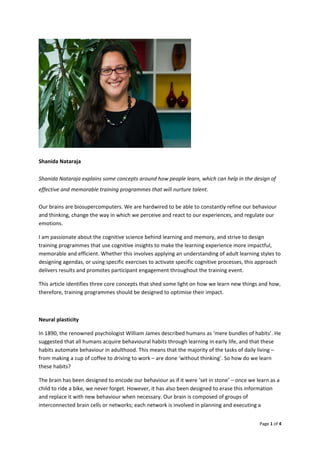
Brain potential formatted 5Jun15_SN
- 2. Page 2 of 4 particular task. Connections between our brain cells can be strengthened or weakened, much like the way the volume on a sound system can be turned up or down by moving the volume dial. Within each network, when brain cells frequently communicate with each other, the connections between them become strengthened. It usually takes very few repetitions of a task before we start to do the task ‘without thinking’. The connections become stronger, so that not only do we complete the task more quickly, but we also do so with minimal thought or effort. The wiring of our brain takes on an imprint of the task. Should a new method be used to perform the same task, new brain cells will be recruited and old brain cells decommissioned, the old imprint erased and a new imprint formed. This flexible, malleable quality of the brain is referred to as neural or brain plasticity. Every new experience, every incoming stimulus, brings about a change in our brain’s configuration – our hardwiring. The plasticity underlies learning and memory, and is a key to unravelling some of the mysteries of human behaviour. “We can continue to learn new things and adapt our behaviour, perceptions and emotions even up to the day we die” The myth that a new habit can be created in 21 days has been debunked, and evidence from researchers at University College London suggests that it can take between 2 and 8 months to embed a new habit; however, the upshot of neural plasticity is that we can continue to learn new things and adapt our behaviour, perceptions and emotions even up to the day we die. Impact on how training should be delivered: repetition, repetition, repetition is the key to effective training. Not only should key concepts be presented repeatedly in training sessions, in slightly different ways, but it is also important to give participants the opportunity to put into practice what they have learned, so they can fully embed the new behaviour. The cognitive operators In the early 21st century, the neuroscientists Eugene D’Aquili and Andrew Newberg put forward the theory that the human mind was composed of seven processing units, called cognitive operators. Each of these represents a specific function of the mind and, collectively, they allow us to interpret and assign emotional significance to our experiences. The holistic operator produces the ‘big picture’, the ability to see how objects or experiences fit into a wider context, such as the architectural theme of a building. The reductionist operator allows us to dissect problems or objects into their component pieces, and analyse them in a rational, logical and sequential fashion. The causal operator identifies the cause of a particular experience or series of events, and is responsible, at least in part, for our drive to understand why things happen.
- 3. Page 3 of 4 The abstractive operator generates abstract concepts, such as ‘an orange and a pineapple are both fruit’, and allows us to suggest a way in which two pieces of information are related, assembling these pieces of information into a complete theory that explains their relationship. The binary operator allows us to make sense of our world by dividing it into pairs of opposing concepts, such as light/dark, good/evil and inside/outside. The quantitative operator, as the name suggests, allows us to define objects in terms of their quantity. The emotional value operator assigns emotional significance to a particular event. Most of us have all seven of these cognitive operators, and there is evidence that at least some of them are pre‐programmed into the circuitry of the developing brain: humans are thus hardwired to perform these particular cognitive functions and thus derive meaning from our experiences within the world. “Training should be designed to trigger the appropriate cognitive operators” Impact on how training should be delivered: training should be designed to trigger the appropriate cognitive operators; the learner should be: ‐ Given information to help them understand the big picture of what they are trying to achieve ‐ Presented with a process that breaks down the task at hand into easy‐to‐digest chunks ‐ Provided with an explanation of why they are at the training in the first place and why a presented process or tool works ‐ Shown how separate concepts or tools can be abstractly categorised to aid retention, such as a mnemonic device to remember a series of process steps ‐ Given lists that detail positive and negative attributes, dos and don’ts, things to remember and things to avoid ‐ Provided with the means of measuring or quantifying performance, impact of training and successful implementation of tools and strategies ‐ And, most importantly, emotionally engaged in the training process and having fun, as you are more likely to remember training that you have enjoyed. The power of intention and attention Intention is the conscious will to behave in a particular way and attention is the conscious focusing of awareness in order to perform the intended behaviour. Intention The fundamental principle of any training is that the person receiving the training must want to be there, and must recognise that there is a need for them to work on specific skills or expand their knowledge base on a particular topic. This is easy if the training is voluntary, of course, but in many
